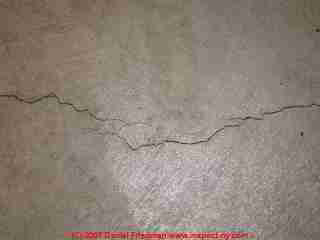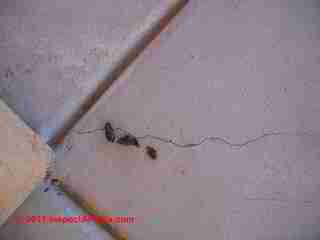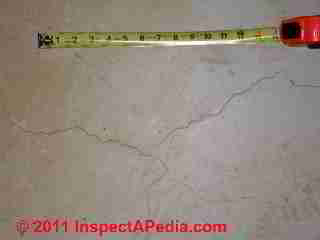 Concrete Foundation Shrinkage Crack Repair Methods
Concrete Foundation Shrinkage Crack Repair Methods
- POST a QUESTION or COMMENT about when and how to repair shrinkage cracks in concrete foundations, walls, floors.
How to repair concrete foundation shrinkage cracks: this article describes how to repair shrinkage cracks in poured concrete foundations.
The photo above shows a typical shrinkage crack in poured concrete.
At this website we explain how it is sometimes possible to be confident about the cause of foundation damage which in turn helps assess the risk presented to the building and the repair methods needed for foundation damage, cracks, leaning, buckling, bowing, settlement.
InspectAPedia tolerates no conflicts of interest. We have no relationship with advertisers, products, or services discussed at this website.
- Daniel Friedman, Publisher/Editor/Author - See WHO ARE WE?
Repair Methods for Foundation Shrinkage Cracks
Diagnose the Concrete Crack Before Repairing It

Before repairing a foundation crack it is important to diagnose the cause of the crack and its effects on the building structure.
Our photo (left) shows a shrinkage crack (horizontal in the photo) near the corner of two control joints in a poured concrete floor of a Tucson Arizona home. (The insect fragments on the crack were left for scale).
We suspect that at this job the control joints were not properly formed, perhaps not deep enough. But of course a shrinkage crack could have occurred even with perfect control joints, depending on the concrete mix, site preparation, and the conditions at the time the mix was poured.
The significance of any foundation crack depends on the crack's cause, size, shape, pattern, location, foundation materials, extent of cracking, impact of the crack on the building, and possibly other factors as well.
If there is an underlying ongoing problem causing foundation movement or damage, that problem needs to be corrected too.
Cracks in poured concrete walls that are larger than 1/4", cracks which are increasing in size, or cracks which are otherwise indicative of foundation movement should be evaluated by a professional.
At SHRINKAGE CRACKS in SLABS we discuss how we decide if a foundation crack needs repairing the first place.
The diagnosis and evaluation of foundation cracks and structural foundation damage and repair methods are discussed extensively at FOUNDATION REPAIR METHODS
Suggestions for Repairing Concrete Foundation Shrinkage Cracks
 Repairs to foundation cracks which are not traced to building movement, structural problems, site problems, or other conditions which require site or structural repairs
may be attempted for cracked foundations and other cracked concrete structural elements using a variety of products and materials
such as masonry repair epoxy or sealant products.
Repairs to foundation cracks which are not traced to building movement, structural problems, site problems, or other conditions which require site or structural repairs
may be attempted for cracked foundations and other cracked concrete structural elements using a variety of products and materials
such as masonry repair epoxy or sealant products.
These products, some of which include even structural repair epoxies, might be used to seal against water leakage as well, and may be used for repairing certain cracks in concrete foundations following evaluation and advice from a foundation professional.
An evaluation of the presence, absence, or condition of reinforcing steel in cracked concrete foundations should be a part of such an inspection.
Our photo (above-left) shows concrete shrinkage cracks in a new home in Pawling, New York. There was no water entry and no vertical movement in the slab (no trip hazard).
Absent water or radon leaks or a trip hazard, these cracks were, in our opinion, of cosmetic concern only and did not need to be repaired for structural reasons.
Watch out: even an apparently harmless crack in a poured concrete floor should be repaired or bridged with an appropriate mesh tape and sealant product before installing ceramic tile over the floor, to reduce the chances that the crack later telegraphs through the tile.
How are Concrete Shrinkage Cracks Repaired?
 Shrinkage cracks, which are not normally a structural defect in a building, may nonetheless need to be sealed against water entry. Common shrinkage crack repair methods include
Shrinkage cracks, which are not normally a structural defect in a building, may nonetheless need to be sealed against water entry. Common shrinkage crack repair methods include
- Chipping out the crack and applying a concrete masonry patching compound to the surface - the chipping procedure is labor intensive: the crack is chipped out in an "inverted-vee" pattern (wider at the bottom and more narrow at the top) to assure that the patch remains soundly in the crack.
The prepared crack is vacuumed to remove loose particles and dust. Special surface preparation chemicals can assist in bonding of the concrete patch material to the crack. - Concrete repair epoxies: the crack should be clean and dry and at a temperature recommended by the epoxy manufacturer. Some epoxies may permit application in damp or wet conditions or even in cold weather.
- Polyurethane injection sealants. Some polyurethanes may permit application in damp or wet conditions or even in cold weather.
- Special concrete caulks or other sealants. Some sealants and special caulks may permit application in damp or wet conditions or even in cold weather.
Stopping Water entry leaks at foundation cracks
Polyurethane foam sealant is used for foundation crack repairs to stop water entry. (Also find and correct outside water sources). See our article on POLYURETHANE FOAM INJECTION CRACK REPAIRS for details on using this product to seal foundation cracks against leakage.
Watch out: best practice in stopping water entry at any foundation crack (shrinkage, settlement, etc) is to find and correct the root cause: the source of water.
Or if your foundation is excavated from outside, see WATER BARRIERS, EXTERIOR BUILDING.
For various methods and products used to seal cracks in concrete floors or walls, see SEAL CONCRETE CRACKS, HOW TO a description of various products and methods used to seal or repair cracks in poured concrete walls, foundations, floors, & slabs.
Once any concrete cracks it is possible for water to leak into the building through the crack. There are several ways to repair a basement crack leak.
An easy, quick, and effective measure to stop basement or crawl space water entry through a foundation crack is to perform an injection of polyurethane foam into the basement crack.
Also be sure to find and fix the sources of water outside.
Water entry leaks at foundation cracks: Polyurethane foam sealant is used for foundation crack repairs to stop water entry. (Also find and correct outside water sources).
See POLYURETHANE FOAM INJECTION CRACK REPAIRS.
...
Continue reading at SEAL CONCRETE CRACKS, HOW TO or select a topic from the closely-related articles below, or see the complete ARTICLE INDEX.
POLYURETHANE FOAM INJECTION CRACK REPAIRS
Or see these articles, books, & products about
Repair of Foundation Cracks
For detailed information about foundation repair methods, including repairs to various kinds of cracks in concrete, see:
- SEAL CONCRETE CRACKS, HOW TO - you are currently on this web page.
- FOUNDATION REPAIR METHODS for shrinkage cracks
- POLYURETHANE FOAM INJECTION CRACK REPAIRS for details of the procedure for using polyurethane foam to seal foundation cracks.
- CONTROL JOINT CRACKS in CONCRETE how we prevent shrinkage cracks in poured concrete floors and walls
- FOUNDATION REPAIR METHODS for our catalog of Foundation Repair Methods - Examples of Typical Foundation Repairs for various types of foundation cracks, leaks, settlement, movement, or other failures
- "Best Practices for Concrete Sidewalk Construction," Balvant rajani, Canadian National Research Council
- "Design Considerations for Perlite Roof Slabs," a chapter in "Perlite Concrete Grade for Lightweight Concrete Construction", United Perlite Corporation
- Quality Standards for the Professional Remodeling Industry, [Book at Amazon] National Association of Home Builders Remodelers Council, NAHB Research Foundation, 1987.
- Quality Standards for the Professional Remodeler, [Book at Amazon] N.U. Ahmed, # Home Builder Pr (February 1991), ISBN-10: 0867183594, ISBN-13: 978-0867183597
- Lone Star Epoxies, [Website] Rowlett TX, product literature, includes application instructions for this flexible epoxy resin concrete expansion joint sealer. ls@lsepoxies.com - 10/06/08
- Ramset™ Epoxy Grout, [PDF] Australia,
- Laticrete™ [Website] Epoxy grout
Suggested citation for this web page
SHRINKAGE CRACK REPAIRS at InspectApedia.com - online encyclopedia of building & environmental inspection, testing, diagnosis, repair, & problem prevention advice.
Or see this
INDEX to RELATED ARTICLES: ARTICLE INDEX to BUILDING STRUCTURES
Or use the SEARCH BOX found below to Ask a Question or Search InspectApedia
Ask a Question or Search InspectApedia
Try the search box just below, or if you prefer, post a question or comment in the Comments box below and we will respond promptly.
Search the InspectApedia website
Note: appearance of your Comment below may be delayed: if your comment contains an image, photograph, web link, or text that looks to the software as if it might be a web link, your posting will appear after it has been approved by a moderator. Apologies for the delay.
Only one image can be added per comment but you can post as many comments, and therefore images, as you like.
You will not receive a notification when a response to your question has been posted.
Please bookmark this page to make it easy for you to check back for our response.
IF above you see "Comment Form is loading comments..." then COMMENT BOX - countable.ca / bawkbox.com IS NOT WORKING.
In any case you are welcome to send an email directly to us at InspectApedia.com at editor@inspectApedia.com
We'll reply to you directly. Please help us help you by noting, in your email, the URL of the InspectApedia page where you wanted to comment.
Citations & References
In addition to any citations in the article above, a full list is available on request.
- "Concrete Slab Finishes and the Use of the F-number System", Matthew Stuart, P.E., S.E., F.ASCE, online course at www.pdhonline.org/courses/s130/s130.htm
- Diagnosing & Repairing House Structure Problems, Edgar O. Seaquist, McGraw Hill, 1980 ISBN 0-07-056013-7 (obsolete, incomplete, missing most diagnosis steps, but very good reading; out of print but used copies are available at Amazon.com, and reprints are available from some inspection tool suppliers). Ed Seaquist was among the first speakers invited to a series of educational conferences organized by D Friedman for ASHI, the American Society of Home Inspectors, where the topic of inspecting the in-service condition of building structures was first addressed.
- Design of Wood Structures - ASD, Donald E. Breyer, Kenneth Fridley, Kelly Cobeen, David Pollock, McGraw Hill, 2003, ISBN-10: 0071379320, ISBN-13: 978-0071379328
This book is an update of a long-established text dating from at least 1988 (DJF); Quoting:
This book is gives a good grasp of seismic design for wood structures. Many of the examples especially near the end are good practice for the California PE Special Seismic Exam design questions. It gives a good grasp of how seismic forces move through a building and how to calculate those forces at various locations. THE CLASSIC TEXT ON WOOD DESIGN UPDATED TO INCLUDE THE LATEST CODES AND DATA. Reflects the most recent provisions of the 2003 International Building Code and 2001 National Design Specification for Wood Construction. Continuing the sterling standard set by earlier editions, this indispensable reference clearly explains the best wood design techniques for the safe handling of gravity and lateral loads. Carefully revised and updated to include the new 2003 International Building Code, ASCE 7-02 Minimum Design Loads for Buildings and Other Structures, the 2001 National Design Specification for Wood Construction, and the most recent Allowable Stress Design. - In addition to citations & references found in this article, see the research citations given at the end of the related articles found at our suggested
CONTINUE READING or RECOMMENDED ARTICLES.
- Carson, Dunlop & Associates Ltd., 120 Carlton Street Suite 407, Toronto ON M5A 4K2. Tel: (416) 964-9415 1-800-268-7070 Email: info@carsondunlop.com. Alan Carson is a past president of ASHI, the American Society of Home Inspectors.
Thanks to Alan Carson and Bob Dunlop, for permission for InspectAPedia to use text excerpts from The HOME REFERENCE BOOK - the Encyclopedia of Homes and to use illustrations from The ILLUSTRATED HOME .
Carson Dunlop Associates provides extensive home inspection education and report writing material. In gratitude we provide links to tsome Carson Dunlop Associates products and services.

